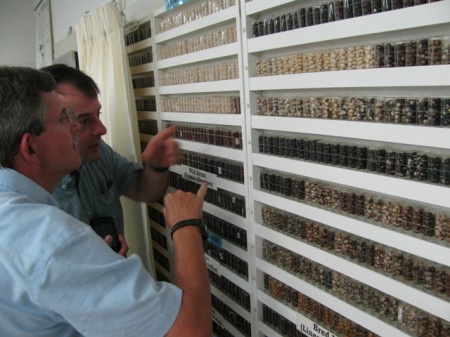Check out one of the illustrations in Brainpicking’s review of a recent book on the Academy of Natural Sciences of Philadelphia (“which stands today as the oldest natural history museum in the Western Hemisphere,” and just celebrated its 200th anniversary). It’s the one labelled “Agricultural seed samples collected by Charles F. Kuenne, 1948,” towards the bottom of the page. I’m trying to find out who Mr Kuenne was. Or is. He’s not mentioned in GRIN, alas. But what I wanted to talk about was the sort of glass jars that he — and many others — used to store and display his seeds.
I always thought they were pretty useless, as you can virtually guarantee that the seeds will be dead in short order stored like that. Of course keeping them alive was not the point, and you can now extract DNA from much worse samples. But the fact of the matter is it that during last week’s trip to the CIAT genebank I saw bean breeders look at the assembled ranks of little grain-filled vials on display there so longingly, and lovingly, I cannot but revise my opinion.

Who needs fancy databases when you can just run your eyes past thousands of different bean samples in a few seconds? Having said that, if you search the CIAT database you will find the varieties Red Valentine (G07707) and Rust Proof Golden Wax (G09523) collected by Kuenne — though not his actual samples, of course. They’re in Philadelphia.
One Reply to “A glass vial of beans is worth a thousand database entries”